In the early 1980s, there were virtually no films featuring America’s pastime. The previous most successful baseball themed movie had been “the Bad News Bears”, a comedy about Little League baseball and a drunken coach played by Walter Matthau. That film came out in 1976. In 1984, Barry Levinson delivered “the Natural” and in the next ten years, there were more than eighteen films featuring the game of baseball. Do you suppose that is a coincidence? I’ve read a few criticisms of “The Natural” as a movie in the last couple of months. With no disrespect to those who have a different opinion, I’d have to say that “The Natural” is one of the most influential baseball films of all time, and that it may be one of the most beautiful movies ever made.
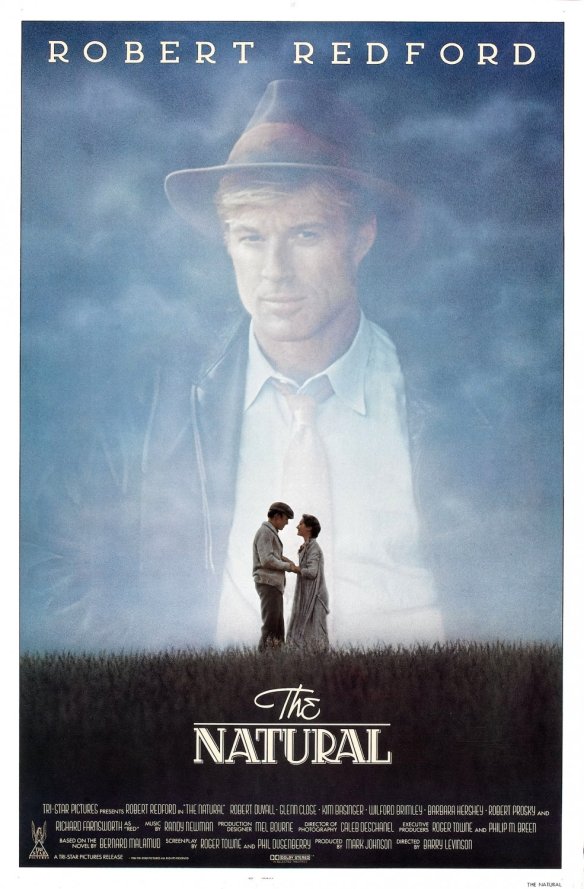 Many defenders of “the Natural” have gone as far as to say that the movie is not really about baseball. There are scholarly attempts to explain it through the prism of “The Iliad” and “The Odyssey”. There are allegories and direct references to mythology and the gods. I can’t say that any of those thoughts are wrong, I can say however, that the movie is about baseball more than anything else and regardless of the inspirations or literary roots, baseball is the source of it’s strengths.
Many defenders of “the Natural” have gone as far as to say that the movie is not really about baseball. There are scholarly attempts to explain it through the prism of “The Iliad” and “The Odyssey”. There are allegories and direct references to mythology and the gods. I can’t say that any of those thoughts are wrong, I can say however, that the movie is about baseball more than anything else and regardless of the inspirations or literary roots, baseball is the source of it’s strengths.
Before I get to the baseball issues, there are a couple of historical points about the movie that I would like to mention. “The Natural” was the first film produced and released by “Tri-Star” studios, the first new major American film company in many years. It was expected to be the debut of the Tri-Star logo and brand. The studio, however had picked up the Universal castoff film “Where the Boys Are” and released it a couple of months earlier, so “The Natural” did not get to carry the mark of being the first. I remembered reading the review of “The Natural” in the L.A. Times, and it was not particularly positive. The sentence that I can recall the best is that at the premiere, the loudest response was from all the company employees when the winged horse from the logo made it’s appearance. Whoever that reviewer was (Sheila Benson, Charles Champlin or Kevin Thomas), they should have been with the opening night crowd I saw the picture with in Orange County California. There was exuberance and cheering and a very satisfied audience at the closing credits. No one there except me I suppose, was very interested in seeing the Tri-Star logo, we were all looking forward to a Robert Redford sports film.
Before we get to the meat and potatoes of this look back, let’s take a listen to one of the side dishes that come with this hearty meal.
Randy Newman’s score is iconic and intricate. It has been compared to a Copeland suite and it is so memorable and evocative of myth that it is used regularly in other films, TV shows and commercials. This was his second film to be nominated for the music by the Academy and one of the eighteen that he has not won for. It is his signature orchestral piece.
I was a fan of baseball as a kid, my grandfather and great uncle would sit in the living room of my grandparents house and listen to Vin Scully and Ross Porter do the Dodger games on the radio. Summer afternoons and weekends seemed to have an endless run of games that they followed religiously. When I was in high school, I went to a couple of games with friends and read the sports pages, but I was a pretty passive fan. It was 1984 when I had the greatest involvement on a personal level with baseball, because that year, my wife and I got cable. I wanted my MTV, but what really hooked me was WGN, which showed every Cubs game and in those days the Cubs home games were only played in the daytime, no lights at Wrigley field. In the Spring, I came home from class and watched the Cubs everyday. They had a fantastic season that year. I also watched several Tigers games, and I don’t know how it happened but I saw Jack Morris pitch a no-hitter on TV. It might have been that this movie just hit me at the right time and that’s why I remembered loving it.
Well thirty years have passed, I have not been to a Dodger’s game since Fernando Valenzuela was pitching and football is now my sport of choice. Yet when I watched “The Natural” for this project, I got a very familiar vibe. I was seeing something magical and rooted deep in the culture. The myth that I see being celebrated in the film has nothing to do with Ulysses and everything to do with America and our past. I see in “The Natural” the striving values that sometimes blind us to our own best interests. I see the seduction that lures us from our destiny and the back stabbers that would steal our glory. There are moments of joy and despair. There are characters that are easy to love and some that reek of the Snidely Whiplash variety. All of this takes place in the world of baseball with stunning moments of histrionics and quiet moments of contemplation.
 I just happened across a post at one of my favorite on-line haunts, that featured a look at heroic silhouette images. Well here is one to add to the collection, as Roy Hobbs prepares to step out of the dark that has sidetracked him for sixteen years and into the drab, but somehow dazzling field of the New York Knights. A miracle that has been delayed is about to play out for us and this movie is going to soak us in images and events that shape such a miracle.
I just happened across a post at one of my favorite on-line haunts, that featured a look at heroic silhouette images. Well here is one to add to the collection, as Roy Hobbs prepares to step out of the dark that has sidetracked him for sixteen years and into the drab, but somehow dazzling field of the New York Knights. A miracle that has been delayed is about to play out for us and this movie is going to soak us in images and events that shape such a miracle.
Before the above moment occurs however, there is nearly a half hour of set up that needs to be admired for the imagery and simplicity with which it sets up the redemptive story we are about to see. Much like the first part of the original “Superman” movie, the audience is treated to a background story on our hero. Roy Hobbs as a kid is a vision of mid-west nostalgia. A thriving crop and a supportive and wise father, set the stage for some dramatic turns.  He has catch with his father in a honey golden field of promise. The cute little girl from the neighboring farm idolizes him and his Dad can see that there is something special about his boy, but not so special that he can achieve greatness without some effort. His father’s words will echo through the rest of the movie, because Roy will have to struggle. Mostly against despair. The struggle starts when he loses his mentor. The magic of hard work is realized not through a montage of training sequences, but through the self made bat that Roy fabricates out of the wood from a tree struck by lightning that hovered over his fathers resting place.
He has catch with his father in a honey golden field of promise. The cute little girl from the neighboring farm idolizes him and his Dad can see that there is something special about his boy, but not so special that he can achieve greatness without some effort. His father’s words will echo through the rest of the movie, because Roy will have to struggle. Mostly against despair. The struggle starts when he loses his mentor. The magic of hard work is realized not through a montage of training sequences, but through the self made bat that Roy fabricates out of the wood from a tree struck by lightning that hovered over his fathers resting place.  Like the innocent and hopeful kid he is, Roy gives his magic staff a name that could only come from a pure hearted farm boy. As he will soon learn, the game he loves is not quite as pure as he is and the veneer of hope that every baseball game and season begins with, will be peeled back by cynical writers, jaded stars and most horrifying of all, seductive takers of glory. All of this will be done with a calm, steady pace and an eye for beauty in the movement of trains, the blowing of curtains in the wind and the golden light of “Magic Hour” to show us the path that must be taken to achieve something meaningful.
Like the innocent and hopeful kid he is, Roy gives his magic staff a name that could only come from a pure hearted farm boy. As he will soon learn, the game he loves is not quite as pure as he is and the veneer of hope that every baseball game and season begins with, will be peeled back by cynical writers, jaded stars and most horrifying of all, seductive takers of glory. All of this will be done with a calm, steady pace and an eye for beauty in the movement of trains, the blowing of curtains in the wind and the golden light of “Magic Hour” to show us the path that must be taken to achieve something meaningful.
Three major characters are introduced in this prologue of Roy’s journey. Two of those figures do not return after this section, but their presence haunts the rest of the story. There is the giant of a legend that represents baseball at the time. They never say he is “The Babe” but it is obvious that “the Whammer” is the doppelganger for the Sultan of Swing. Roy’s naivete is confronted by the boastful self centered attitude of a man who could easily be his hero but becomes a subject of disappointment for his indifference to strangers.
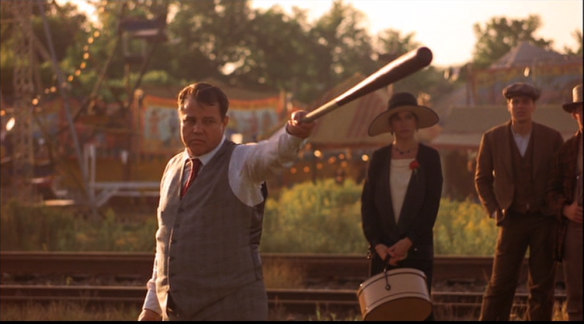 As the great Joe Don Baker, pantomimes the famous called shot of Babe Ruth, Roy strikes him out on the agreed upon three pitches. This signals his status as potentially the greatest of all time, and it changes the targeting of the succubus like character of Harriet Bird. She has been stalking the slugger but chooses a new target in the young phenom. The reasons for her actions are maybe well explained by some of those analyses that I mentioned before. The Greeks may have a name for the plot point, but all you need to know is that she has taken down Roy by playing on his drive to be the best and willingness to test the waters outside of the paradise we know he originates from. You can see Barbara Hershey in the background of the above shot, reprogramming her attention even as the events play out before us. The desire for greatness and the desire to kill that greatness are both introduced in this event. It sets up the rest of the story which will play out in greater detail and less lethal ways, but still mythic in proportion.
As the great Joe Don Baker, pantomimes the famous called shot of Babe Ruth, Roy strikes him out on the agreed upon three pitches. This signals his status as potentially the greatest of all time, and it changes the targeting of the succubus like character of Harriet Bird. She has been stalking the slugger but chooses a new target in the young phenom. The reasons for her actions are maybe well explained by some of those analyses that I mentioned before. The Greeks may have a name for the plot point, but all you need to know is that she has taken down Roy by playing on his drive to be the best and willingness to test the waters outside of the paradise we know he originates from. You can see Barbara Hershey in the background of the above shot, reprogramming her attention even as the events play out before us. The desire for greatness and the desire to kill that greatness are both introduced in this event. It sets up the rest of the story which will play out in greater detail and less lethal ways, but still mythic in proportion.
The third character is Max Mercy. A sportswriter who antagonizes Roy early on. He is the character that comes back into this story after the opening set up. He has forgotten where he has seen Roy before, and he becomes a thorn in Roy’s side for the rest of the picture. Robert Duvall had won the Academy Award for Best Actor a month before this movie opened, and here he is in a character part that doesn’t reflect his status but does reflect his talent. His character here is closer to Frank Hackett from “Network” than it is to the award winning role of Mac Sledge from “Tender Mercies”, it shows his broad range and ability to adapt to the style of film he is appearing in. His cynicism is the grindstone that Roy must hone himself on if he is to live up to the potential that his father once saw in him.
When Redford emerges from the dugout tunnel he encounters two new characters that are the delight of the film. Wilford Brimley is Pop Fisher, the co-owner/manager of the New York Knights major league team. With his walrus mustache and gruff manner, he epitomizes the kind of old school baseball founder that dominated the leagues in the 1920s and 30s.  His right hand man is coach Red Blow. Farnsworth is a stunt guy who turned into an on screen actor in the later stages of his career, and made us all wonder where he had been for the first fifty years of his life. When these two are playing name that tune by whistling during practice, you know that you are getting a “real feeling ” moment if not a moment of reality. Old-timers talk, they cajole and they bitch to one another and these two are finely matched, creating the type of sympathetic characters that you want Roy to come through for.
His right hand man is coach Red Blow. Farnsworth is a stunt guy who turned into an on screen actor in the later stages of his career, and made us all wonder where he had been for the first fifty years of his life. When these two are playing name that tune by whistling during practice, you know that you are getting a “real feeling ” moment if not a moment of reality. Old-timers talk, they cajole and they bitch to one another and these two are finely matched, creating the type of sympathetic characters that you want Roy to come through for.
The movie is packed with performers who are well cast and create the right atmosphere. The beautiful Kim Basinger is Memo Paris, a more subtle version of Harriet Bird. She does not seek to kill Roy, just to poison him with the cynicism and avarice that will corrupt his mission. Originally she was the girlfriend of the previous star of the Knights Bump Baily. Bump is played by Michael Madsen, in a part much more expansive than his earlier turn in 1984 in “Racing with the Moon”. He doesn’t stick around long but he exits the stage in a dramatic, humorous and foreboding manner. His fate sets the stage for Roy to become a star, but also foretells of the dangers that lurk ahead on his path. 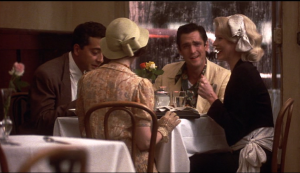 Memo turns out to be one of three malevolent figures in the background of the story. As the main female lead and the direct line to Roy’s emotional life, I think she is the main villain of the piece. She is not in charge, she is not the mastermind, but she is the point of the knife that the would be despoilers of the game will use to achieve their ends. Also on that side of the equation is the co-owner of the team, “The Judge” a man cloaked in darkness. Almost every time he appears,Robert Prosky is shown in shadows. Clearly a deliberate choice to emphasize the questionable ethics and motivations of the character.
Memo turns out to be one of three malevolent figures in the background of the story. As the main female lead and the direct line to Roy’s emotional life, I think she is the main villain of the piece. She is not in charge, she is not the mastermind, but she is the point of the knife that the would be despoilers of the game will use to achieve their ends. Also on that side of the equation is the co-owner of the team, “The Judge” a man cloaked in darkness. Almost every time he appears,Robert Prosky is shown in shadows. Clearly a deliberate choice to emphasize the questionable ethics and motivations of the character. 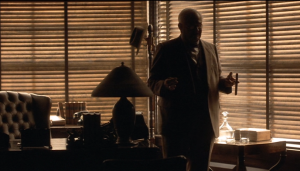 “The Judge” flatters, entices, threatens and attempts to bribe Hobbs to accomplish his ends. Roy’s loyalty to the game is illustrated by his flipping the lights on in the Judge’s office at the end of their first meeting. The character is oily and mean. If the devil were to appear in his natural state as a human, “The Judge” would be a good guess as to what he would look like. Of course the real devil would disguise himself and try to appear as a corrupt but at least honest and forthright monster. The better to snake his way into a persons heart. The direct power of the Judge never seems as serious as the indirect threat presented by gambler Gus Sands.Darren McGavin was a late addition to the cast and rather than jockey and negotiate his credits he went without a credit in the film. His Gus is the real antagonist of the film. His openly corrupt and avuncular persona allows him to be seen as a sideshow issue, but it is his power to corrupt the game of baseball that makes him a true threat.
“The Judge” flatters, entices, threatens and attempts to bribe Hobbs to accomplish his ends. Roy’s loyalty to the game is illustrated by his flipping the lights on in the Judge’s office at the end of their first meeting. The character is oily and mean. If the devil were to appear in his natural state as a human, “The Judge” would be a good guess as to what he would look like. Of course the real devil would disguise himself and try to appear as a corrupt but at least honest and forthright monster. The better to snake his way into a persons heart. The direct power of the Judge never seems as serious as the indirect threat presented by gambler Gus Sands.Darren McGavin was a late addition to the cast and rather than jockey and negotiate his credits he went without a credit in the film. His Gus is the real antagonist of the film. His openly corrupt and avuncular persona allows him to be seen as a sideshow issue, but it is his power to corrupt the game of baseball that makes him a true threat. 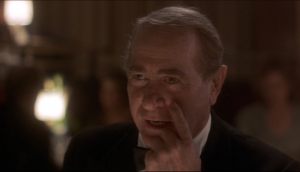 When he first meets Roy in the company of Memo and Max, they are dining at an opulent nightspot. Everyone seems to be enjoying the moment, but Gus shows off his talent for looking into people. He nearly gets Roy on the nose with a guess about how much cash he is carrying. He claims to have a magic eye and indeed, the character has been given a larger, different colored eye, to make us uncomfortable and put us on edge over whether there really are supernatural forces at work here. The greek myth of a cyclops is evoked, and we know that when the devil wants to make a deal, he can spot a rube a mile away. Near the end of the movie, when everyone else on the side of corruption is worried, Gus is dismissive, he knows he is right and he is confident that they will prevail and save the money that a bribe would have cost them.
When he first meets Roy in the company of Memo and Max, they are dining at an opulent nightspot. Everyone seems to be enjoying the moment, but Gus shows off his talent for looking into people. He nearly gets Roy on the nose with a guess about how much cash he is carrying. He claims to have a magic eye and indeed, the character has been given a larger, different colored eye, to make us uncomfortable and put us on edge over whether there really are supernatural forces at work here. The greek myth of a cyclops is evoked, and we know that when the devil wants to make a deal, he can spot a rube a mile away. Near the end of the movie, when everyone else on the side of corruption is worried, Gus is dismissive, he knows he is right and he is confident that they will prevail and save the money that a bribe would have cost them.
Now I know that the criticisms of the movie focus on a couple of things that others see as faults but I see as pluses. One blogger put it this way,
I have to disagree because in this world, sports figure do command adulation, their legacies are celebrated like heroes, and thousands of kids play the game in a way that means more than just a couple of hours outdoors in the sunshine. When football cards command the same prices as baseball cards do, when soccer players are immortalized by actors like Gary Cooper, and when grown men stop weeping at the conclusion of “Field of Dreams”, then maybe I will believe that baseball is a sport like any other. Speaking of Field of Dreams, I think James Earl Jones character has the best answer to a thought like this:
Terence Mann: Ray, people will come Ray. They’ll come to Iowa for reasons they can’t even fathom. They’ll turn up your driveway not knowing for sure why they’re doing it. They’ll arrive at your door as innocent as children, longing for the past. Of course, we won’t mind if you look around, you’ll say. It’s only $20 per person. They’ll pass over the money without even thinking about it: for it is money they have and peace they lack. And they’ll walk out to the bleachers; sit in shirtsleeves on a perfect afternoon. They’ll find they have reserved seats somewhere along one of the baselines, where they sat when they were children and cheered their heroes. And they’ll watch the game and it’ll be as if they dipped themselves in magic waters. The memories will be so thick they’ll have to brush them away from their faces. People will come Ray. The one constant through all the years, Ray, has been baseball. America has rolled by like an army of steamrollers. It has been erased like a blackboard, rebuilt and erased again. But baseball has marked the time. This field, this game: it’s a part of our past, Ray. It reminds of us of all that once was good and it could be again. Oh… people will come Ray. People will most definitely come.
The improbable miracles that are dismissed in this movie are not as farfetched as some people might think. Curt Schilling, pitching in the playoffs with a tear in his surgery repaired ankle, Kurt Gibson limping up to the plate with a hamstring injury only able to hit and not play otherwise, it’s not hard to find wildly unlikely scenarios where the sport reaches the mythic proportions suggested by this movie.
 Yes, there are moments that defy credulity, but they are satisfying mythological moments that are in the range of the possible. So what that Roy knocks the cover off the baseball, that’s the kind of wild idea we all dream of and there it was in front of us.
Yes, there are moments that defy credulity, but they are satisfying mythological moments that are in the range of the possible. So what that Roy knocks the cover off the baseball, that’s the kind of wild idea we all dream of and there it was in front of us.  Roy clobbers the ball into the upper decks. When injured and testing his ability to play, he manages to chase Max out of the stands with some well hit balls. His magic bat shatters and he instills his magic into the bat that was made by a kid who he inspired. He breaks a hit-less streak after spotting his abandoned true love in the stands as she stands up haloed by golden sunlight. That is the inspirational myth that we are living through but it only works because it is baseball. The pace of the game, the moments of one man facing off against another. Baseball is different. It is the only game where the offense does not have control of the ball. It is a game where a dramatic moment can be sustained for almost six minutes. If you have the time, here is the perfect example:
Roy clobbers the ball into the upper decks. When injured and testing his ability to play, he manages to chase Max out of the stands with some well hit balls. His magic bat shatters and he instills his magic into the bat that was made by a kid who he inspired. He breaks a hit-less streak after spotting his abandoned true love in the stands as she stands up haloed by golden sunlight. That is the inspirational myth that we are living through but it only works because it is baseball. The pace of the game, the moments of one man facing off against another. Baseball is different. It is the only game where the offense does not have control of the ball. It is a game where a dramatic moment can be sustained for almost six minutes. If you have the time, here is the perfect example:
I don’t find most of the complaints about the myth-making to be worrisome because that is what baseball does, creates moments of myth that lovers of the game share for years afterwards. Glenn Close standing up and restoring the innocence and dream of the slightly corrupted Roy is a perfect cinema moment. It is a movie, and film is about exaggerating reality to make the story resonate with us. Tell me this image does not do exactly that.
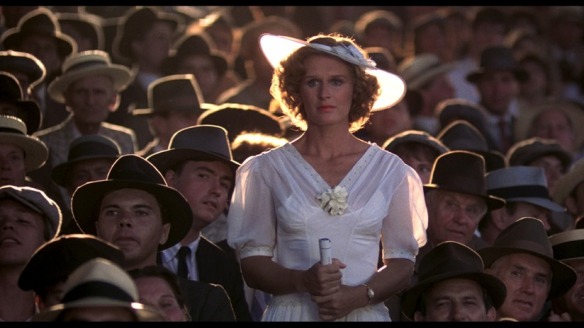 The look of the film is marvelous. I read another recent review where the author pointed out the use of the “magic hour” lighting in the film. His comment was:
The look of the film is marvelous. I read another recent review where the author pointed out the use of the “magic hour” lighting in the film. His comment was:
“It all looked beautiful, but the same lighting style grew tiresome after a while. “
The vision we have of those times is often based on the images from books and movies from the past. Caleb Deshanel, who was robbed of the Academy Award the previous year for his work on “The Right Stuff”, repeats as an Oscar nominee with this film. The night scenes are just as gorgeous as those outdoor sunset scenes are. The interiors are lit in a way to evoke the time and place in the film. Does every moment in the movie look like it could be a painting to hang on the wall? Yes, but that is not a bad thing and for a movie seeking to make the game it portrays into something special, it is essential that the film not look like a Sidney Lumet thriller in NYC, or a gangster picture from the 1970s. 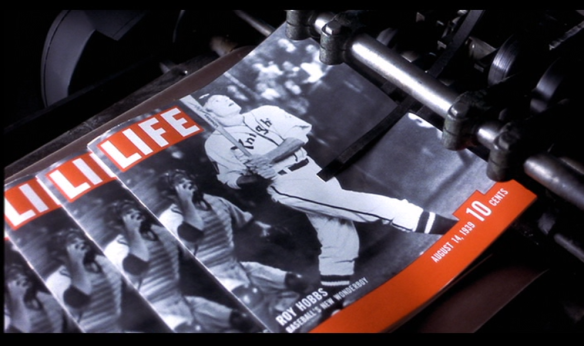 Even the inserts of montage event headlines, newsreels and magazine covers look hyper real and spectacular. When I saw that this was on the list of “1001 Movies to See Before You Die”, I was a little surprised. When I watched the movie I was not. This is a myth inspiring baseball film that paved the way for “Bull Durham”, “Eight Men Out”, “Field of Dreams”, “Major League”, “A League of Their Own” and “The Sandlot”. If “The Natural” had been as forgettable as some other baseball movies, with the cast and care that went into it, you know that these followers would not have ever been green-lighted. To me, that alone would be enough to make it one of the great movies of 1984. Everything else is gravy, and there is a lot of gravy as far as I’m concerned.
Even the inserts of montage event headlines, newsreels and magazine covers look hyper real and spectacular. When I saw that this was on the list of “1001 Movies to See Before You Die”, I was a little surprised. When I watched the movie I was not. This is a myth inspiring baseball film that paved the way for “Bull Durham”, “Eight Men Out”, “Field of Dreams”, “Major League”, “A League of Their Own” and “The Sandlot”. If “The Natural” had been as forgettable as some other baseball movies, with the cast and care that went into it, you know that these followers would not have ever been green-lighted. To me, that alone would be enough to make it one of the great movies of 1984. Everything else is gravy, and there is a lot of gravy as far as I’m concerned.
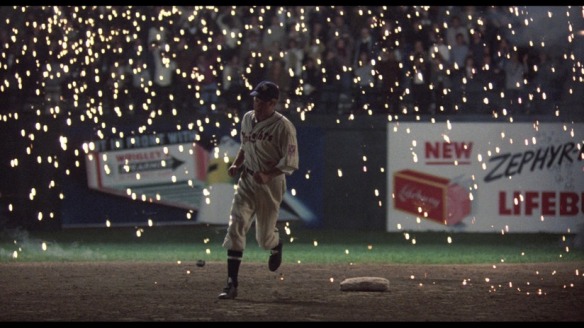 (My Thanks to S.J. Honeywell and Jay Cluitt for the inspiration)
(My Thanks to S.J. Honeywell and Jay Cluitt for the inspiration)

God, I love this film! Hard to believe it’s been 30 years. Splendid examination, Richard. Well done, my friend.
Agreed! That is one of the great heroic silhouettes on film, Richard.
When I saw the post you had up, I immediately ran the movie on the computer to get a screen shot of that moment. I loved this more after ‘re-watching for the project. Thanks for the kind words.
I’m a big fan of the book by Saul Bellow. The film was great in parts–like the lights burst at the ball park.
Some people think those moments were over done, but if they had not existed, we would not be talking about this film today. Great to have you come by Cindy.
As one of the bloggers quoted above and as someone who does think this film is overdone, I feel like I should explain myself. I get the love for it, and I don’t completely disagree with everything you’ve said here, but I still wouldn’t put this on my top-5 of baseball movies.
I look at this in comparison with Field of Dreams in particular, since both films are about myth and baseball. The main difference between them is that Field of Dreams deals with the myths that are already there–Joe Jackson, the Black Sox, even Moonlight Graham. It puts those myths into perspective. The Natural attempts to show us the myths as they are being created. They have to be larger than life because they don’t have the benefit of time to become that way. It may well be my hang up here, but for me, it loses its credibility by forcing the myth rather than letting the myth simply become that way.
Bull Durham has it’s own moment of myth making with Crash Davis breaking the all-time minor league record for home runs. And it’s passed off without even a mention in the Sporting News, we’re told. That I buy.
The supernatural elements are more prevalent in Field of Dreams, and the players and their impact are mostly reflections. The Natural is a story told in its time although it is set in the past, the events take place in the contemporary and real world. No one would be a bigger advocate of both of the other films being on the list, and the stories might be better, but the myth and the visuals in this movie are more cinematic and as I said neither would have been made had the foundation not been laid out by this movie. Thanks for your comments and for your original post, I was more enthusiastic when working on this because of your work.
This is one of those classics that I haven’t seen yet but really feel like I should!
It is great to look at and It will be a good film to clear off that blind spot list. Thanks for letting me know you are stopping by.
Amazing review! I love the Natural and it by far my favourite baseball movie of all time. Robert Redford is just superb as Roy Hobbes and when he hits that game winning home run, that is one of Hollywoods greatest cinematic sports moments.
Thanks for the compliment. I might favor Bull Durham but this is an iconic feature and Redford was perfect for it. I loved it more after re-watching for this project. Thanks for stopping by.
That’s kinda funny, it seems like most baseball fans I know love Bull Durham too. I’ve only seen it once in my life and wasn’t impressed. I like For Love of the Game also with Costner more then that.
Bull Durham is far more quotable and romantic. For Love of the Game is more meditative as I recall. I’ve seen Bull Durham dozens of times, For Love of the Game once. If you like Costner sports films (and I do) you might really enjoy Draft Day. I have a post up on it on the other blog if you are interested.
http://kirkhamclass.blogspot.com/2014/03/draft-day.html
Hey! I finally went over and read your Draft Day review and loved it. It offered up a unique perspective into the world of sports that we haven’t seen in a while. I consider Draft Day one of the best pictures of 2014 so far.
Outstanding review! The Natural is one of my all time favorite films, and it has truly stood the test of time. The points you made regarding certain characters and aspects of the movie are very spot on. I have posted this on Twitter.
Glad you liked it. Thanks for sharing it with your followers, all are welcome here.
Pingback: A Summer Place: Year of Bests – 2014 | It Rains... You Get Wet
Pingback: Country | 30 Years On: 1984 a Great Year for Movies
The Natural was written by Bernard Malamud, and he meant it pretty satirically
I understand that they took some big liberties in the direction of the story. What did you think of those changes? Could the movie have worked if the stuck with the original tone and ending?